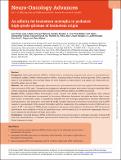| dc.contributor.author | Zats, Liat Peretz | |
| dc.contributor.author | Ahmad, Labiba | |
| dc.contributor.author | Casden, Natania | |
| dc.contributor.author | Lee, Meelim J | |
| dc.contributor.author | Belzer, Vitali | |
| dc.contributor.author | Adato, Orit | |
| dc.contributor.author | Bar Cohen, Shaked | |
| dc.contributor.author | Ko, Seung-Hyun B | |
| dc.contributor.author | Filbin, Mariella G | |
| dc.contributor.author | Unger, Ron | |
| dc.contributor.author | Lauffenburger, Douglas A | |
| dc.contributor.author | Segal, Rosalind A | |
| dc.contributor.author | Behar, Oded | |
| dc.date.accessioned | 2023-02-03T18:20:35Z | |
| dc.date.available | 2023-02-03T18:20:35Z | |
| dc.date.issued | 2022 | |
| dc.identifier.uri | https://hdl.handle.net/1721.1/147868 | |
| dc.description.abstract | Abstract
Background. High-grade gliomas (HGG) in children have a devastating prognosis and occur in a remarkable spatiotemporal pattern. Diffuse midline gliomas (DMG), including diffuse intrinsic pontine gliomas (DIPG), typically
occur in mid-childhood, while cortical HGGs are more frequent in older children and adults. The mechanisms behind this pattern are not clear.
Methods. We used mouse organotypic slice cultures and glial cell cultures to test the impact of the microenvironment on human DIPG cells. Comparing the expression between brainstem and cortical microglia identifed differentially expressed secreted proteins. The impact of some of these proteins on DIPGs was tested.
Results. DIPGs, pediatric HGGs of brainstem origin, survive and divide more in organotypic slice cultures
originating in the brainstem as compared to the cortex. Moreover, brainstem microglia are better able to support tumors of brainstem origin. A comparison between the two microglial populations revealed differentially
expressed genes. One such gene, interleukin-33 (IL33), is highly expressed in the pons of young mice and its DIPG
receptor is upregulated in this context. Consistent with this observation, the expression levels of IL33 and its receptor, IL1RL1, are higher in DIPG biopsies compared to low-grade cortical gliomas. Furthermore, IL33 can enhance
proliferation and clonability of HGGs of brainstem origin, while blocking IL33 in brainstem organotypic slice cultures reduced the proliferation of these tumor cells.
Conclusions. Crosstalk between DIPGs and the brainstem microenvironment, in particular microglia, through IL33
and other secreted factors, modulates spatiotemporal patterning of this HGG and could prove to be an important
future therapeutic target. | en_US |
| dc.language.iso | en | |
| dc.publisher | Oxford University Press (OUP) | en_US |
| dc.relation.isversionof | 10.1093/NOAJNL/VDAC117 | en_US |
| dc.rights | Creative Commons Attribution 4.0 International license | en_US |
| dc.rights.uri | https://creativecommons.org/licenses/by/4.0/ | en_US |
| dc.source | Oxford University Press | en_US |
| dc.title | An affinity for brainstem microglia in pediatric high-grade gliomas of brainstem origin | en_US |
| dc.type | Article | en_US |
| dc.identifier.citation | Zats, Liat Peretz, Ahmad, Labiba, Casden, Natania, Lee, Meelim J, Belzer, Vitali et al. 2022. "An affinity for brainstem microglia in pediatric high-grade gliomas of brainstem origin." Neuro-Oncology Advances, 4 (1). | |
| dc.contributor.department | Massachusetts Institute of Technology. Department of Biological Engineering | en_US |
| dc.relation.journal | Neuro-Oncology Advances | en_US |
| dc.eprint.version | Final published version | en_US |
| dc.type.uri | http://purl.org/eprint/type/JournalArticle | en_US |
| eprint.status | http://purl.org/eprint/status/PeerReviewed | en_US |
| dc.date.updated | 2023-02-03T18:13:38Z | |
| dspace.orderedauthors | Zats, LP; Ahmad, L; Casden, N; Lee, MJ; Belzer, V; Adato, O; Bar Cohen, S; Ko, S-HB; Filbin, MG; Unger, R; Lauffenburger, DA; Segal, RA; Behar, O | en_US |
| dspace.date.submission | 2023-02-03T18:13:43Z | |
| mit.journal.volume | 4 | en_US |
| mit.journal.issue | 1 | en_US |
| mit.license | PUBLISHER_CC | |
| mit.metadata.status | Authority Work and Publication Information Needed | en_US |
